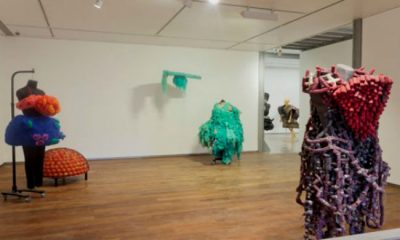What would I make of a jumpsuit created out of pills, capsules and fibre, were I to encounter someone wearing it pass by on the road? Would my response be the same as it was now, when I see the ‘garment’ in the gallery space, conscious that it is an artwork?
I think, as I traverse through the exhibition space at Gallery Chemould, where Vivan Sundaram’s new show titled Gagawaka: Making Strange opened last month.
Sundaram is one of India’s most acclaimed and respected artists, and his previous exhibition, called Trash, comprising an installation, digital photographs and video works, ‘explored the compulsions of inhabiting a city made of abject material even as his works addressed issues crucial to these questions.
I look at a suit made out of capsule wrappers and the ‘Pill-Fill Jumpsuit’ created out of pills and capsules; it seems to point to the decay and degeneration characteristic of the body. It also reminds me about how many in our country are proverbial ‘guinea pigs’ for global pharma giants wanting to test their ‘breakthrough medicines’.
The ‘effigy’, another of Sundaram’s creations made out of paper cups that we sip our chai and coffee from, signifies the dated nature of what we possess and wear in the name of ‘latest fashion’; paper cups will be discarded soon after their utility is over, like all fashion trends that die out once the market has wrung out all that it possibly can. Elements from the trends can then, of course, become hangers-on for other things–their value can be resurrected in the creation of something else, like Sundaram does with the paper cups.
The use of foam sponges and sheets in the ‘Aztec Deity’ points to the subversive element that runs through all the works in the show. Sundaram does not use things in the manner that they are meant to be by their producers–as creative agents, we have the ability to shape a different narrative out of the raw materials at our disposal. And so, in Gagawaka, we have garments created out of sanitary pads, truck tyre tubes, drainpipes, orthopaedic support et al. The exhibits underscore the connection between the seductive lure of the spectacle, and the degenerate nature that it seeks to hide; they make the latter obvious and apparent.
But does this making-apparent-the-hidden-nature, the subversion, help critique the market, the system that props up the spectacle? Apparently. At least, Sundaram believes so.
“Garbage is a product of modernity; a society of consumption,” he said in an interview. “In some sense, it [the art work] responds to the world around me. It’s a larger social statement, but is also a playful juxtaposition of something that exists in our society – chaos and anarchy.”
Yet, the sharpness of the social statement is lost for several reasons.
Sundaram chooses to locate the exhibition in a gallery space, where his ‘wearable art objects’ are vying for buyers who will ‘possess’ them. In a sense, therefore, they are vying to become a part of the same milieu that he critiques.
The grammar of the ‘performance’ that was part of the show in Delhi, and the video of which runs on a loop at Gallery Chemould, was largely that of any of a high-profile fashion show. Seeing ‘models’–professionals, and friends and colleagues of the artist–sashay down the ramp in his creations, you could easily be mistaken to assume that they were part of any of the fashion weeks in the country. If this show is meant to explore the relationship between art and fashion, a large part of the ‘performance’ would make one feel that Sundaram has created fashion, and not art.
But it may be worthwhile to question whether the distinction matters here at all. Since, at the end of the day, Sundaram’s works are also commodities that are sold in the market, peopled by the same elite who consume creations of high fashion.
The overarching system, with its logic of consumerism and consumption, which Sundaram seems to critique through his show, is the same system that has propped up his exhibition, and his persona as an artist that enables his work to be labelled as ‘art’. Would the works that the artist has created find space in a gallery if they were created by some fresher out of art school? Unlikely. Sundaram does nothing to subvert this aspect of his creations.
In attempting to critique the spectacle that is fashion and the forces that support it, Sundaram has created yet another spectacle that seeks to develop into nothing but itself.


